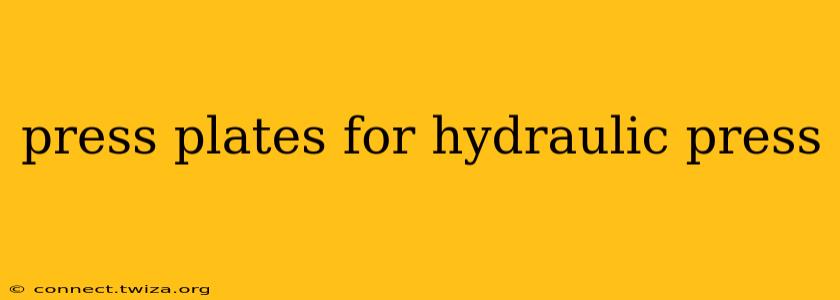Hydraulic presses are powerful machines used in various industries for tasks like forming, bending, and straightening metal. The press plates are crucial components, directly interacting with the workpiece and transmitting the immense force generated by the hydraulic system. Choosing the right press plates is paramount for safety, efficiency, and the longevity of your equipment. This guide dives deep into the world of hydraulic press plates, addressing common questions and concerns.
What are Hydraulic Press Plates Made Of?
The material of your press plates is dictated by the application. Common materials include:
-
Steel: A versatile and robust choice, offering excellent strength and durability. Different grades of steel, such as high-carbon steel or alloy steel, are selected based on the required strength and resistance to wear. For example, high-carbon steel might suffice for lower-pressure applications, while alloy steels are necessary for high-pressure, high-temperature operations.
-
Cast Iron: Provides good compressive strength and excellent damping properties, making it suitable for applications requiring shock absorption. It’s often a cost-effective option for less demanding tasks.
-
Tool Steel: A premium option boasting superior hardness, wear resistance, and ability to hold a precise shape. This makes tool steel ideal for applications requiring intricate details or prolonged use under heavy pressure.
-
Other Materials: In specialized applications, you might find press plates made of materials like hardened aluminum, composites, or even tungsten carbide, depending on the needs of the job.
How Do I Choose the Right Size Press Plate?
Selecting the correct size press plate is critical for both safety and effectiveness. Several factors influence this decision:
-
Workpiece Dimensions: The press plates must be large enough to fully encompass the workpiece, ensuring even pressure distribution. Insufficient size can lead to uneven deformation or damage to the workpiece and the press itself.
-
Press Capacity: The plates must be able to withstand the maximum force generated by the hydraulic press without bending or breaking. Always select plates with a safety factor exceeding the press's capacity.
-
Plate Thickness: Thickness influences the plate's strength and resistance to bending. Thicker plates are needed for higher pressures and larger workpieces.
Proper sizing calculations often require consultation with the press manufacturer or a qualified engineering professional.
What are the Different Types of Press Plates?
Press plates come in various configurations designed to address specific needs:
-
Flat Plates: The most common type, suitable for general-purpose applications.
-
Specialty Plates: These can incorporate features such as:
- Grooved Plates: To improve grip and prevent workpiece slippage.
- Angled Plates: For specialized bending operations.
- Plates with Cutouts: For applications requiring access to specific areas of the workpiece.
How Often Should I Replace My Press Plates?
The lifespan of press plates depends on several factors, including:
- Material: Higher-quality materials naturally last longer.
- Frequency of Use: Intensive use leads to faster wear and tear.
- Application: Severe applications involving abrasive materials will require more frequent replacements.
- Maintenance: Regular inspection and maintenance can extend the plates' lifespan.
Regular inspections for signs of wear, cracks, or deformation are crucial. Replacements should be done promptly to avoid accidents and maintain the press’s effectiveness.
How Much Do Press Plates Cost?
The cost varies significantly based on the material, size, and type of press plate. High-quality tool steel plates will be considerably more expensive than standard steel plates. The best approach is to obtain quotes from multiple suppliers, providing them with detailed specifications of your needs.
Where Can I Find Press Plates for My Hydraulic Press?
Press plates can be purchased from various industrial supply companies and specialized hydraulic press equipment suppliers. It’s advisable to source plates from reputable suppliers who can guarantee the quality and suitability of their products for your specific application.
This comprehensive guide provides a solid foundation for understanding hydraulic press plates. Remember, always prioritize safety and consult with professionals when selecting and using these critical components. Improperly sized or maintained plates can lead to equipment damage, injury, and costly downtime.
